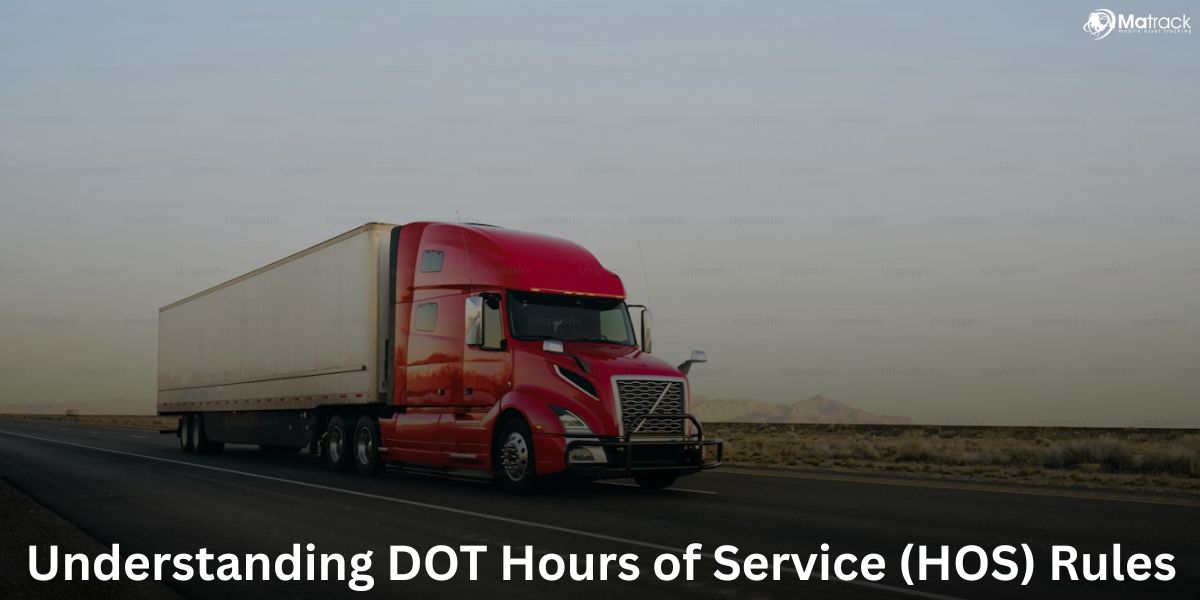Key Takeaways
- Hazmat trucks are built to transport dangerous materials like gases, flammable liquids, and toxic chemicals under strict federal safety rules.
- There are four types of hazmat trucks, each matched to the form and risk level of the material being transported.
- Drivers must complete CDL endorsement, TSA clearance, and DOT training to legally operate hazmat trucks.
- Matrack telematics systems improve safety by tracking location, logging driver activity, and detecting vehicle issues in real time.
What Are Hazmat Trucks?
Hazmat trucks are specialized commercial vehicles designed to carry hazardous materials such as flammable liquids, toxic chemicals, explosives, and compressed gases. These trucks handle substances that pose serious risks to health, property, and the environment.
To ensure safe transport, hazmat trucks must meet regulatory standards outlined in the Hazardous Materials Regulations (HMR). These rules control how trucks are built, maintained, and operated during transport.
The design of each truck depends on the type of material it carries, requiring reinforced tanks, sealed valves, or heat-resistant linings. These construction differences define the various types of hazmat trucks used across industries.
What Are the Types of Hazmat Trucks?
Hazmat trucks differ in structure and function based on the type of hazardous material they transport. The variation depends on material composition, temperature sensitivity, and containment requirements.
Tank Trucks
Tank trucks are built to carry flammable liquids and gases such as gasoline, propane, and anhydrous ammonia. Their cylindrical, insulated tanks help maintain pressure stability and prevent combustion.
Dry Bulk Trucks
Dry bulk trucks transport granulated or powdered hazardous materials like ammonium nitrate and lime powder. These trucks use sealed, pressurized trailers to avoid contamination and minimize dispersion.
Flatbed Trucks
Flatbed trucks handle oversized or containerized hazardous cargo, including radioactive materials and industrial waste drums. These loads are fastened externally with specialized restraints for visibility and ventilation.
Refrigerated Trucks
Refrigerated trucks are designed for temperature-sensitive hazardous substances such as biomedical samples and pharmaceutical chemicals. They feature cold chambers and thermal control systems to preserve chemical integrity.
Each type of hazmat truck is matched to the physical form and handling needs of the material it carries. These materials are grouped by hazard type, which determines how they must be packaged, labeled, and transported.
What Are the 9 Hazard Classes in Hazmat Trucking?
The U.S. Department of Transportation (DOT) defines nine hazard classes to categorize the specific threats hazardous materials pose during transport.
These classifications determine how materials are packaged, labeled, and handled throughout the logistics process.
- Explosives: These materials detonate under heat, shock, or friction. Common examples include fireworks, TNT, and blasting caps.
- Gases: This class covers flammable, toxic, or pressurized gases such as propane, chlorine, and butane that pose combustion or inhalation risks.
- Flammable Liquids: These ignite easily at low temperatures and include substances like gasoline, ethanol, and acetone.
- Flammable Solids: Materials like magnesium and sulfur fall under this class due to their ability to ignite from friction, heat, or moisture.
- Oxidizers and Organic Peroxides: These chemicals intensify combustion by releasing oxygen, with hydrogen peroxide and ammonium nitrate being common examples.
- Toxic and Infectious Substances: Contact or exposure to these materials, such as pesticides and biomedical waste, can cause severe health effects.
- Radioactive Materials: Substances like uranium and cesium emit ionizing radiation, which presents long-term biological and environmental risks.
- Corrosives: These cause irreversible damage to skin, metals, or infrastructure. Examples include hydrochloric acid and sodium hydroxide.
- Miscellaneous Dangerous Goods: Materials like lithium batteries and dry ice do not fit into the other classes but still present serious transport risks.
Hazard classes serve as the legal foundation for how hazardous materials must be managed. These classifications directly inform the laws and agencies responsible for governing hazmat trucking.
What Laws Govern Hazmat Trucks?
Hazardous Materials Transportation Act (1975)
The HMTA act gives the federal government full authority over hazardous materials transport. It sets the legal base for all other hazmat regulations.
49 CFR Parts 100–185
49 CFR federal rules outline how hazardous materials must be labeled, packaged, tested, and routed. Every carrier must comply with these technical standards.
Federal Motor Carrier Safety Administration (FMCSA)
FMCSA monitors the safety of hazmat carriers by enforcing rules on inspections, licensing, and driving records.
Pipeline and Hazardous Materials Safety Administration (PHMSA)
PHMSA writes and updates the core safety rules for hazmat transport and manages emergency planning requirements.
These legal controls define the responsibilities of every carrier and place strict requirements on the drivers themselves. That makes proper training essential for anyone operating a hazmat truck.
What Training Is Required for Hazmat Truck Drivers?
Every hazmat truck driver must hold:
- CDL with Hazmat Endorsement (H): Drivers must pass a written knowledge test.
- TSA Background Check: Fingerprinting, ID verification, and federal clearance are mandatory.
- DOT Hazmat Training: Includes general awareness, safety protocols, function-specific handling, and emergency response.
- Recurrent Certification Every 3 Years: Keeps drivers updated with regulation changes.
Driver certification supports risk prevention, but vehicle design is equally critical. Built-in truck safety systems reduce failure points during hazmat transit.
Safety Features of Hazmat Trucks
Hazmat trucks integrate safety systems that reduce mechanical failure, chemical exposure, and fire hazards. These features are standardized across compliant fleets to control operational risk.
Placards and Labels
Each truck displays hazard classification placards on all four sides to alert emergency responders and the public to the contents in transit.
Spill-Resistant Valves
Tanks include pressure-tested seals and controlled-release valves to prevent leaks during collisions or rollovers.
Emergency Information Papers
Drivers carry physical documentation listing material details, hazard identifiers, and immediate containment instructions.
Vehicle Inspection Logs
Federal Motor Carrier Safety Administration (FMCSA) mandates daily checks for brake systems, lighting, tires, and tank conditions.
Fire Suppression Systems
Trucks use integrated extinguishers, foam systems, and thermal barriers to minimize ignition risk near flammable materials.
While these features limit technical failure, the cargo itself introduces significant safety challenges. Hazardous materials increase physical, environmental, and public exposure risks during transit.
What Risks Do Hazmat Trucks Pose?
Hazmat trucks increase health risks when toxic substances leak during transport. Exposure can cause breathing problems, skin burns, and nausea.
Spills from these trucks often pollute soil, rivers, and groundwater. Cleanup is difficult and long-term damage can harm wildlife and local water supplies.
When flammable materials are involved, the chance of fire or explosion is high. These accidents cause property loss and more deaths on highways near populated areas.
How Matrack Telematics Systems Improve Hazmat Truck Safety?
Matrack telematics systems give dispatchers real-time oversight of hazmat truck movement and driver activity. The ELD device automatically logs driving hours, helping prevent fatigue and ensuring federal compliance.
Driving data reveals patterns like sudden braking or speeding that point to risky behavior. The fleet dash cam adds visual context, capturing events on the road that support safety reviews and coaching.
Mechanical alerts warn fleet managers when issues like brake wear or tire pressure drops occur. GPS fleet tracking keeps routes visible at all times, making it easier to respond to detours, delays, or emergencies.



